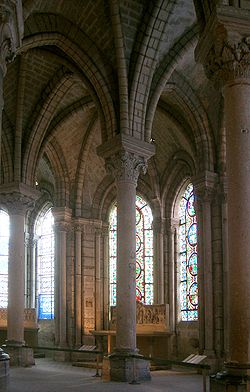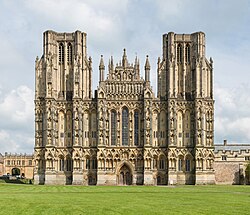English Gothic architecture
English Gothic is the name of the architectural style that was very popular in England from about 1180 until about 1520. As with the gothic architecture of other parts of Europe, English Gothic is defined by its pointed arches, vaulted rooves, buttresses, large windows, and spires.
Features of the Gothic style
- Pointed arches
- Very high towers, spires and rooves
- Clustered columns: tall columns that looked like a group of thin columns bundled together
- Ribbed vaults: arched ceilings made of stone. In the Gothic style they were held up by stone ribs.
- A skeleton of stonework with big glass windows in between.
- Tracery: carved stone lace in the windows and on the walls
- Stained glass: richly coloured glass in the windows, often with pictures telling stories
- Buttresses: narrow stone walls jutting out from the building to help hold it up
- Flying buttresses: buttresses that help to hold the vault up. They are made with an arch that jumps over a lower part of the building to reach the outside wall.
- Statues: of saints, prophets and kings around the doors
- Many sculptures, sometimes of animals and legendary creatures. Gargoyles spout water from the roof.[1][2]
Stages
The various styles are seen at their best in the cathedrals, abbey churches and college buildings. It is a distinctive characteristic of the cathedrals of England that all but one of them show great stylistic diversity and have building dates that range over 400 years. The exception, Salisbury Cathedral, was built in 38 years.
- Early English (roughly 1170-1240)
- Decorated (roughly 1250−1350)
- Geometric (1250–90)
- Curvilinear (1290–1350)
- Perpendicular (roughly 1350−1520)
Early English
Examples: Salisbury Cathedral, Whitby Abbey, the nave and transept of Wells Cathedral (1225—1240).
Characteristics
It is called perpendicular because of its emphasis on vertical lines. This is particularly obvious in the design of windows, which became very large, sometimes of immense size, with slimmer stone mullions than in earlier periods. This allowed more scope for stained glass craftsmen. Buttresses and wall surfaces are likewise divided up into vertical panels. Another major development of this period was fan vaulting.
Some of the finest features of this period are the magnificent timber rooves. Hammerbeam rooves, like those of Westminster Hall (1395), and Christ Church Hall, Oxford, appeared for the first time. In areas of southern England elaborate decoration in flint was used, especially in the wool churches of East Anglia.
Decorated gothic
Examples: the east ends of Lincoln Cathedral and Carlisle Cathedral, and the west fronts of York Minster and Lichfield Cathedral. Much of Exeter Cathedral is built in this style.
Perpendicular gothic

Some of the earliest examples of the "perpendicular period", from 1360, are found at Gloucester Cathedral. The masons of the cathedral seem to be far in advance of those in other towns; the fan-vaulting in the cloisters is particularly fine. Also noteworthy are the Quire and tower of York Minster (1389–1407); the nave and western transepts of Canterbury Cathedral (1378–1411). Bath Abbey, Eton College Chapel and King's College Chapel, Cambridge (1446–1515) are also examples.
English Gothic Architecture Media
Salisbury Cathedral (1220–1258) (tower and spire later)
Salisbury Cathedral choir
Southwell Minster choir
Worcester Cathedral nave
Beverley Minster transept
York Minster south transept
Hereford Cathedral (1079–1250) lady chapel
Peterborough Cathedral west front
Wells Cathedral west front
References
- ↑ Fletcher, Banister 2001. A History of Architecture on the comparative method. Elsevier Science & Technology. ISBN 0-7506-2267-9
- ↑ Swaan, Wim. Art and Architecture of the Late Middle Ages. Omega Books. ISBN 0-907853-35-8












